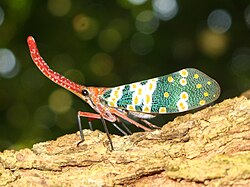Planthopper
Planthoppers are insects in the infraorder Fulgoromorpha. They are true bugs (Hemiptera), with over 12,500 described species.
| Planthopper | |
|---|---|

| |
| Phromnia rosea (Flatidae) adults and nymphs | |
| Scientific classification | |
| Unrecognized taxon (fix): | Fulgoromorpha |
They are cryptic mimics: their body shape and colours look like leaves and other plant parts in their environment. They either walk very slowly or hop like grasshoppers.
Members of this group are plant-feeders, and live world-wide. Few are pests, but some are vectors for plant diseases. Phytoplasmas which live in the phloem of plants can be transmitted by planthoppers when feeding.[1][2]
Their nymphs have a biological gear mechanism at the base of the hind legs, which keeps the legs in synchrony when the insects jump.[3]
In popular culture
The planthopper is mentioned in a key scene from Alfred Hitchcock's film Marnie:[4]
- "In Kenya, there is quite a beautiful flower – rather like a hyacinth. If you should reach out to touch it, you would discover that the flower is not a flower at all, but a design made up of hundreds of tiny insects called flatid bugs. They escape the eyes of hungry birds by living and dying in the shape of a flower".
Planthopper Media
Planthopper (Fulgoridae: Pterodictya reticularis) with abdominal filaments of ketoester wax
nymphal Dictyophara europaea (Dictyopharidae)
Acanalonia conica (Acanaloniidae), on the underside of a milkweed leaf
Planthopper nymphs on coneflower stem. Includes a slow motion segment
References
- ↑ Lee et al 2000. Phytoplasmas: phytopathogenic mollicutes. Annual Review of Microbiology 54 p221/255.
- ↑ "Flower-spike / butterfly bug (Phromnia rosea) leaf hopper adults". Nature Picture Library. Retrieved 30 January 2021.
- ↑ Burrows M. & Sutton G. 2013. Interacting gears synchronize propulsive leg movements in a jumping insect. Science 341 (6151),1254-1256 DOI: 10.1126/science.1240284
- ↑ Tony Lee Moral (2002). Hitchcock and the making of Marnie. Manchester University Press. p. 48. Google Books. Retrieved November 16, 2013.








